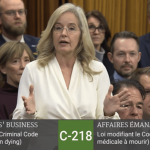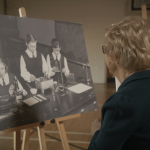With profound sorrow and immense gratitude I learned of the impending death of Benedict XVI while on holiday at the iconic Chateau Lake Louise in Alberta.
In the breakfast room with my wife and a close friend we discussed the news of his kidney failure and the impending funeral.
Looking out the window at the immense mountains and snow, my mind was brought back to Benedict’s native Bavaria, where he was born in 1927, and my visit to his birthplace in 2009.
I felt both sorrow and joy while contemplating the words of Roman scholar Pliny the Elder, “He is gone from us, full of years and full of honours (Plenus annis abiit, plenus honoribus).
In some ways, Benedict was the last leaf on the tree. At age 95, his death marked the end of an era, passing in the same year as our beloved Queen, Elizabeth II.
Just several days earlier I had mailed him a Christmas card, written in Latin and signed with a fountain pen, a customary tradition in the Vatican.
The life, writings, and Petrine ministry of Benedict XVI were immensely formative for me and for all Catholics of today. Benedict spoke from the mountain-top. He shared the message of a simple and deep experience of God, about the simplicity of being a saint.
Among his many contributions, both seen and unseen, was serving as president of the Commission for Drafting the Catechism of the Catholic Church, which was published in 1992 and helped give an immense boost to Catholic life with its gift of clear teaching.

As Cardinal Prefect of the Holy Office and later as Pope, he helped guide the Church during the difficult tempest and aftermath of the unfortunate Sixties cultural and sexual revolution.
In short, Benedict was the Pope of the hour and he lasted only just that long. He was a Pope who knew how to Pope. He was a modern doctor of the Church (Doctor Ecclesiae Universalis), a professor, and a teacher in the scientific sense, much like the scholastic Doctors.
Given the difficult times in the Church and world, I can only say we had him longer than we deserved and less than we needed. His abdication in 2013, due to his advanced age and increased immobilization, was a major loss.
In the days since the death of Benedict on New Year’s Eve – the seventh day of Christmas – many commentators have been relating their personal memories of the German-born Pontiff.
For myself, I was privileged to study in Rome under his pontificate, immersed in the florilegium of his writings as a graduate student at the Pontifical University of St. Thomas Aquinas.
Those were great days – a golden age – to be in Rome. I had always been a big fan of Cardinal Joseph Ratzinger. He had visited my native St. Paul, Minn., in my youth, celebrating Mass at my alma mater, the Chapel of St. Thomas Aquinas at the University of St. Thomas.
On Christmas Eve 1999, I saw him up close for the first time as he and his friend and confessor Cardinal Mayer descended into the Scala Regia of the Apostolic Palace after, presumably, a dinner with Pope John Paul II. They both wore a black beret and black greca coat over their red choir dress.
There was an unforgettable excitement in their eyes as they peered out a window at the vast crowd in St. Peter’s Square, gathered for the occasion of the inauguration of the 2000 Holy Year.

When I moved to Rome in 2004, I picked up a copy of a newly published book by Pope John Paul II entitled, Rise, Let Us Be On Our Way.
Here John Paul reminisces of Ratzinger and pays him the ultimate compliment when he refers to him as churchman of “exceptional theological competence,” writing: “I thank God for the presence and the assistance of this great man, who is a trusted friend.”
When I read this not-so-subtle tribute, I took this as a nod from the aging Pontiff in the direction of his preferred successor. The following year, Ratzinger was Pope.
To my surprise my roommate at the time, Chris Wells of Vatican Radio, predicted the election of Ratzinger, and he further predicted he would take the name Benedict XVI, in honour of the Pope of Peace, Benedict XV, who reigned during the horrors of the First World War.
I have several memories of Pope Benedict that may be of interest.
During my time in Rome I was blessed in many ways. By Divine Providence, I saw Benedict countless times. I did my best to walk to the Vatican every Sunday afternoon at noon to be in St. Peter’s Square and pray with him the Sunday Angelus/Regina Caeli.
I have fond memories of my family accompanying me for this, including my parents, brothers, sisters-in-law, aunt, uncle, and even my grandfather, who was quite aged, born in 1919. In the Paul VI Audience Hall my grandfather was thrilled to be within a few feet of the Pope as he walked down the centre aisle for his birthday celebration.
I met Joseph Ratzinger a total of nine times, including twice before his election to the See of Peter. In addition, I was immensely privileged to receive Holy Communion from him a few times, including once in the Vatican Basilica on Pentecost Sunday.
Cardinal Ratzinger was the most approachable and available prelate in the city of Rome. He was a prince among men. A shy man, he still always had time for people with a smile and said, “Hello” and “thank you.” His command of languages was impressive and his English was impeccable, albeit with a traditional German accent.
My first year in Rome – I remember the date, March 20, 2004 – I attended a lecture he delivered at the Pontifical Oriental Institute. I can still see him as if yesterday, crossing the hallway to visit the outdoor courtyard of the school while the rector showed him around with his secretary.
It was during his lecture that day, delivered in English, that the 77-year-old reminisced about his first trip to Rome during Holy Week, 1962. He also spoke of his attachment to the magnificent orchestral Masses in the Viennese tradition that he grew up with in Bavaria.
For those in the know who wanted to see Cardinal Ratzinger, he celebrated Mass every Thursday at 7 a.m. at the Collegio Teutonico in the Vatican City. This is the German College where seminarians from Germany live, tucked within the walls of the Vatican.
During the Second World War, certain men were hidden and found shelter here by heroic German citizens during the Nazi occupation of Rome, including Sam Derry, author of The Rome Escape Line, a fascinating book published in 1960.
The second time I met Cardinal Ratzinger was there with the Richard McNamara family of St. Paul, Minn. The trick was to be admitted by a sympathetic Swiss Guard at the nearby gate. Richard was first in our group to greet the Cardinal after morning Mass and he flashed a copy of our parish history book and explained where we were from.
The Cardinal, with a wide smile, remarked that our parish was the great St. Agnes Parish in the St. Paul under the pastorate of Monsignor Schuler, a parish with a “great musical tradition.” You can imagine our surprise that he knew our pastor and parish by name, one of the few places outside Austria that offers regular orchestral Masses.
When I moved to Rome to begin my studies in 2004, it was the twilight of the reign of Pope John Paul II. Understandably, I had no idea there would be a new Pope the following year.

Until then, Cardinal Ratzinger could be seen regularly walking across St. Peter’s Square from his apartment in the Piazza della Città Leonina to his office in the Palace of the Holy Office. Not a few of our friends met him this way.
For those of us North American students who were privileged to study in Rome under his pontificate, there are no words to describe the sheer joy of having known him as a neighbour.
How many times did I see him at Castel Gandolfo, where I would unfurl the Bavarian flag of his native homeland and he would give me a special point and wave at the beginning of the audience.
There are so many memories, such as the time I slept outside the Vatican wall one night, watching as the light in his apartment window went out around 11 p.m. and on again at 6 a.m. And the time I met Benedict in 2005 at the Lateran University, reaching out to shake his hand and studying in a quick second the detail of his golden fisherman’s ring. Later that year at World Youth Day in Cologne when the German Pope made his triumphal return to his homeland, he arrived on a boat as one million young people greeted him, many wading into the river, including myself, cheering him across the city.
In 2007 I found myself stranded in the Vienna airport the day before Benedict arrived for his seventh trip outside Italy. I extended my layover and was thrilled to see him in the mountains at the Marian shrine of Mariazell.
And one final memory. After the death of John Paul II and during the novendiali, the official nine days of mourning following the death of a pope, a cardinal was selected to celebrate Mass each day in St. Peter’s Basilica for the repose of the soul of the deceased Pontiff. Cardinal Ratzinger was selected twice to celebrate this Mass. In an act of humility seen only by me and others seated along the central aisle, he did not walk in the centre of the aisle during the procession but off to the side, in deference to the memory of the deceased Pontiff.

There are a great many recollections and memories we all have. To best honour the memory of Benedict XVI I suggest praying for the repose of his soul and reading and studying his many writings. For those interested, I recommend a new website that is currently being developed as a complete compendium of his life and works by those who knew him best, including his private secretary Archbishop Georg Gänswein: benedictusxvi.com.
May the memory of Benedict XVI be eternal and I pray he will continue to inspire a new generation to greatness.
John Paul Sonnen is a former Vancouver writer and history docent.



